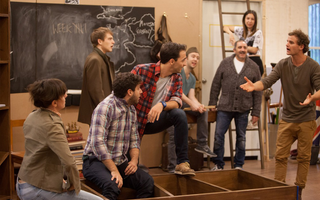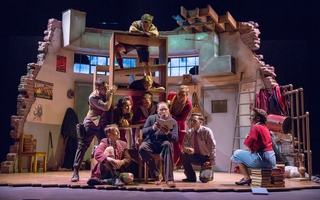In this activity students analyse the visual imagery and metaphors that Henry uses in his most famous speech. They think about this speech as an example of a popular theatrical/literary trope that continues to this day. Using their own creative writing skills, students create their own modern-day equivalent of a motivational speech, based on their analysis of Shakespeare’s text. This task can also be adapted as an analysis of the St Crispin’s Day speech (Act 4, Scene 3).
The character of Henry V is skilled with language and is renowned for delivering some of the most thrilling and powerful speeches in Shakespeare’s body of work. In this activity, students will analyse part of Henry’s most famous speech from Act 3, Scene 1. In this scene, Henry uses the power of his words to inspire his men and convince them to go back into battle:
KING HENRY
Once more unto the breach, dear friends, once more
Or close the wall up with our English dead.
In peace there’s nothing so becomes a man
As modest stillness and humility;
But when the blast of war blows in our ears,
Then imitate the action of the tiger:
Stiffen the sinews, conjure up the blood,
Disguise fair nature with hard-favoured rage.
Then lend the eye a terrible aspect;
Let it pry through the portage of the head
Like the brass cannon; let the brow o’erwhelm it
As fearfully as doth a galled rock
O’erhang and jutty his confounded base,
Swilled with the wild and wasteful ocean.
Group task
In groups of two or three, read over this section of text together. Highlight any words or phrases that you don’t understand and use a dictionary to translate them.
In your groups, discuss what Henry is saying in this speech. What is he trying to get his soldiers to do? What images is he using to illustrate his ideas? Why is his speech so effective?
- The motivational speech is a common trope, not only in theatre, but also in literature, film, and TV. Come up with a list of three examples of motivational speeches from popular culture and discuss the kinds of images and words that characters use to ‘rally’ their listeners. How do the characters use persuasive language and vivid images to influence their audience? What role do emotions play in a motivational speech for both speaker and audience?
Individual task:
- Imagine that you are in a modern-day situation where you need to rally a group of people to complete a task, e.g. a coach before a game or race. Decide on a setting, then create a list of images, metaphors, and persuasive techniques that you could use to convince and motivate your audience. Using these images as a starting point, write a short motivational speech (No more than 250-300 words).





